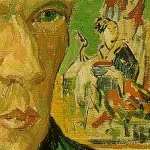

When I ended my last post I was recalling my first visit to Montmartre, back in 2005. My family and I followed Rue des Abbesses to Rue Lepic (the street where Vincent and Theo moved to a few months after Vincent arrived in Paris). We followed Rue Lepic--an upward slanting and curving street that is virtually all residential--until it ended, and then we took a series of turns. At that point we were about as high as one can be on the Butte Montmartre. In fact, we were level with the Basilique du Sacré-Cœur, only behind it now, a block or two away, in an area thriving with restaurants and shops and overrun with crowds of summer tourists. Hot and thirsty, we grabbed a seat at an outside table of one of the cafes. I can't remember what my wife or kids ordered, but I ordered a large Stella Artois draft. And though I'm not a big fan of Stella, I can attest that I savored that one. As we sat and enjoyed our drinks we spied a sign on the wall of the cafe that indicated that the building dated to the nineteenth century and had been then a favorite hangout of the Neoimpressionist community located in Montmartre. I believe the sign even mentioned Van Gogh by name. So, what do you know, we had stumbled onto one of his old watering holes.
When we were finished at the cafe, we wandered the area for a bit longer, checking out some stores, and then found our way back to the Rue Lepic and down the hill again. It was my wife who discovered it: an unassuming, creamy white-toned building with white shutters and dark blue doors, a building that melded almost invisibly into the others lining the east side of Rue Lepic. We'd walked by it the first time without evening noticing. But a rectangular sign with gold letters affixed to the wall near the front door told you: it was the building where Vincent and Theo lived all those years ago. Immediately, of course, we started snapping pictures. My wife made me pose beneath the sign. People walking by studied us curiously, unable to figure why this rather ordinary building should attract such interest.
Well, that was 2005. As it turned out, our camera was having difficulties and we lost most of our pictures from the trip, including half that we took in Paris and almost all we had taken in the south. So part of my reason (albeit a small part) for wanting to return this past summer was to snap some pictures that would last. Indeed, on that cloudy Saturday morning last summer when I arrived in Paris the first place I went after I unloaded my baggage at the hotel was Montmartre. It was far cooler in May 2009 than it had been in August 2005, but not so cool that as to be uncomfortable, especially when the sun peeked out. From the 2005 trip I knew precisely where Vincent and Theo's building was located. I skipped the Basilica and headed toward Rue Lepic, stopping along the way to observe the curve of the streets, the color and architecture of the buildings, the characteristics of the inhabitants. I wanted to burn Monmartre into my memory as well as take dozens of documentary photos. (Such as the ones above.) I examined Vincent and Theo's building again; then, I headed up the street toward the Moulin de la Galette, the umbrella name for two famous windmills--located almost at the heighest point on the street--that Van Gogh depicted in various paintings. An historically significant edifice--it had to be defended during the seige of Paris in 1814--during Van Gogh's lifetime it was regarded as a colorful bit of scenery; a convenient end destination for center town Parisians out for a long walk; and the site of a popular observation deck (at the "Blute-Fin" mill) and a "guinguette" (bar/dancing venue) at the "Radet" mill. Since I'd decided to make the creation of one of Van Gogh's windmill paintings a significant scene in the novel, I lingered for a long time outside the (unfortunately locked) gate to the Blute-Fin mill and then further on to the Radet mill, which tops a still functioning restaurant.
When I'd stood and gawked and photographed as much as I could, I continued on the Rue Lepic until I found the same cafe I'd visited with my family in 2005. This time, instead of sitting outside, I headed in without hesitation. I wanted to sit down, yes, and after the long stretch of Arkansas to Montmartre traveling a tall beer sounded awfully nice, but mostly I just wanted to see the interior, which was narrower and longer, more tightly packed, than I expected. I took my table--the place was almost empty inside--ordered my beer, brought my journal out from my backback, and began recording: what I'd seen and was now seeing, how the day had gone and was going. Without quite realizing it, I was sitting inside what would become the model for Café du Tambourin, the cafe appears in several of my Paris scenes. (Du Tambourin was an actual cafe, but I have no idea of its real life address as it does not operate anymore, at least under that name.) I think at the moment what I felt was pure fatigue, but accompanied by the delicious knowledge that I'd arrived--in Vincent's old neighborhood--and that I was gratefully off my feet; that I had a home here for as long as I wanted it, or at least until my beer ran out.













0 comments:
Post a Comment